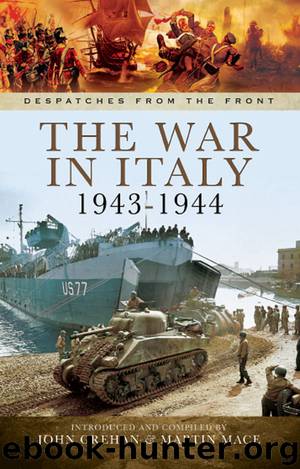THE WAR IN ITALY 1943-1944 by Grehan John & Mace Martin

Author:Grehan, John & Mace, Martin
Language: eng
Format: epub
Publisher: Pen and Sword
Published: 2014-10-29T16:00:00+00:00
The Cassino Position.
I have already described the Liri valley as the gateway to Rome and alluded to the strength of the defences of the gate. A description of the terrain now facing us will make clear the reasons why this one sector was the only place where we could hope to develop an advance in strength and why I was obliged to transfer there ever-increasing forces until by next May the bulk of my Armies was disposed in the Tyrrhenian sector. The Adriatic coastal plain in which Eighth Army had been operating leads nowhere except, eventually, to Ancona. The centre of the peninsula is filled by the Apennines which here reach their greatest height; they were now under deep snow and even in summer are quite impracticable for the movement of large forces. The west coast rises steeply into the trackless Aurunci and Lepini Mountains and the coastal road runs close to the seashore, except for a short stretch in the plain of Fondi, until it debouches into the Pontine Marshes which the Germans had flooded. The Aurunci and Lepini Mountains are separated from the main Apennine range, however, by the valley of the Liri and, further to the north-west, by the valley of its tributary, the Sacco. The gap thereby formed, through which runs Route 6, the Via Casilina, varies in width from four to seven miles. When it reaches the eastern end of the Aurunci chain the Liri meets the Rapido (known also as the Gari for the stretch between Cassino and the confluence) flowing from due north at right angles to its course and the joint stream, now called the Garigliano, flows due south to reach the Tyrrhenian Sea east of Minturno. From the confluence with the Rapido to Ceprano, where the Sacco joins the Liri, the valley is about twenty miles in length with the river on the south side and the road on the north. Undulating and well-wooded towards the north-west the valley gradually loses these characteristics, and open cornfields in the vicinity of Aquino give way to flat pasture land nearer the Rapido. Numerous transverse gullies break up the surface, the most important being the Forme d’Aquino.
The mouth of the valley was closed by formidable defences. To enter it, it is first necessary to cross the Rapido river which, as its name shows, is very swift-flowing; the banks are generally low but marshy, in fact most of the land here is reclaimed land. The Rapido might be compared to the moat before a castle gate and on either hand are two great bastions. To the south Monte Majo, rising to just under three thousand feet, sends down spurs to the river running along its eastern side. The key of the position, however, lies on the north. Here Monte Cairo, over five thousand feet, rears its head as the southernmost peak of a great spur of the Apennines. From its summit a ridge thrusts out, terminating abruptly in Monte Cassino. This is a bare, rocky promontory, seventeen hundred feet high, whose sides drop sharply into the plain beneath.
Download
This site does not store any files on its server. We only index and link to content provided by other sites. Please contact the content providers to delete copyright contents if any and email us, we'll remove relevant links or contents immediately.
The Radium Girls by Kate Moore(11977)
100 Deadly Skills by Clint Emerson(4882)
Rise and Kill First by Ronen Bergman(4741)
The Templars by Dan Jones(4659)
The Doomsday Machine by Daniel Ellsberg(4452)
The Rape of Nanking by Iris Chang(4170)
Killing England by Bill O'Reilly(3973)
Hitler in Los Angeles by Steven J. Ross(3925)
Stalin by Stephen Kotkin(3922)
12 Strong by Doug Stanton(3529)
Hitler's Monsters by Eric Kurlander(3293)
Blood and Sand by Alex Von Tunzelmann(3168)
The Code Book by Simon Singh(3142)
Darkest Hour by Anthony McCarten(3097)
The Art of War Visualized by Jessica Hagy(2975)
Hitler's Flying Saucers: A Guide to German Flying Discs of the Second World War by Stevens Henry(2732)
Babylon's Ark by Lawrence Anthony(2650)
The Second World Wars by Victor Davis Hanson(2504)
Tobruk by Peter Fitzsimons(2481)
